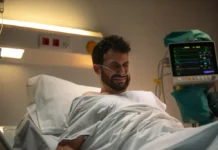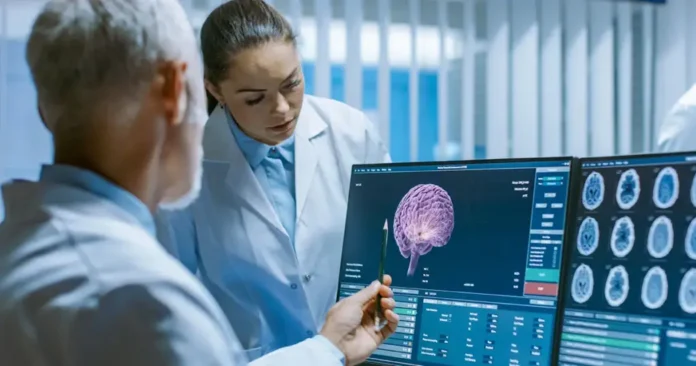Neurosurgery, a specialized branch of medicine, encompasses the diagnosis and surgical treatment of disorders affecting the central and peripheral nervous systems, including the brain, spinal cord, and peripheral nerves. Neurosurgeons, highly skilled physicians specializing in this field, employ advanced surgical and non-surgical techniques to address both adult and pediatric patients.
Within the Neurosurgery Unit at Medical Seek, our team of experienced neurosurgeons utilizes the latest minimally invasive, non-invasive, and open surgical approaches to diagnose, treat, and manage a broad spectrum of neurological conditions. Committed to patient well-being, our compassionate and dedicated team strives to achieve optimal results and help patients regain their quality of life.
The Neurosurgery Division at Medical Seek is renowned for its patient-centered approach and world-class medical care, addressing a comprehensive range of neurosurgical issues, including brain, spine, and nervous system diseases.
Collaborating closely with a multidisciplinary team of specialists from various fields such as anesthesia, oncology, endocrinology, ENT, oral maxillofacial surgery, physiotherapy, and neurotherapy, our American and British board-certified neurosurgeons ensure the best possible treatment outcomes for each patient.
The surgical team at Medical Seek comprises some of the world’s foremost neurosurgeons, spinal surgeons, and brain surgeons. Recognized leaders in their fields, they possess exceptional expertise in the prevention, diagnosis, surgical treatment, and rehabilitation of disorders affecting the nervous system, including those impacting the brain, spinal cord, peripheral nerves, and extracranial cerebrovascular system.
Offering world-class neurosurgical services, our highly skilled neurosurgeons at Medical Seek cater to patients with various neurological disorders, such as cerebral aneurysms, vascular malformations, central nervous system tumors, and other complex conditions. They perform a range of neurosurgical procedures, including craniotomy, endoscopic endonasal surgery, stereotactic surgery, and pituitary adenoma surgery.
Cranial Neurosurgery
Cranial neurosurgery, a specialized field within neurosurgery, involves surgical techniques on the head, where neurosurgeons create an opening in the skull to address medical issues. The multidisciplinary team at Medical Seek’s Cranial Neurosurgery Program possesses extensive experience in various surgical procedures for patients requiring cranial neurosurgery.
Aligned with Medical Seek’s Patients First philosophy, the Cranial Neurosurgery Program offers cutting-edge services unique to the region. These include the use of advanced technologies such as medical navigation systems, endoscopic equipment, continuous electrophysiological intraoperative neuromonitoring (IOM), and fluorescence-guided microsurgery. These technologies ensure the safety and precision of each surgery, tailoring the treatment approach to each patient’s needs.
Conditions We Treat
Various brain conditions may necessitate surgical intervention. While modern medicine has significantly reduced the need for surgery in many cases, surgical intervention may still be required in certain circumstances.
Our team specializes in the three major branches of neurosurgery:
- Brain Surgery – Including endoscopic and awake brain surgery
- Spine Surgery – Visit our dedicated Spine Centre
- Pediatric Neurosurgery – Including newborn conditions
Neurosurgery: A Journey of Precision and Innovation

The art of neurosurgery, which involves intricately addressing neurological disorders through surgical means, boasts a rich medical history spanning millennia. Though its roots date back to ancient civilizations, substantial progress has materialized primarily in the last century. This evolution is a testament to neurosurgeons’ global dedication and ingenuity.
A Glimpse into the Past: Early Neurosurgical Practices
The origins of neurosurgery can be traced to prehistoric times, with archaeological findings suggesting that trepanation—the removal of a portion of the skull—was performed as early as 10,000 BC. These primitive procedures likely aimed to relieve pain, treat epilepsy, or expel perceived evil spirits.
The Dawn of Modern Neurosurgery: The 16th Century and Beyond
A pivotal turning point emerged in the 16th century, marking the development of modern neurosurgery. Andreas Vesalius, a renowned anatomist, published groundbreaking works detailing the structure of the human brain, laying the foundation for a more scientific approach to neurosurgical practices.
Tools of Precision: The Instruments of Neurosurgery
The progress of neurosurgery is intricately tied to the refinement of specialized tools. Modern neurosurgical instruments include chisels, curettes, dissectors, distractors, elevators, forceps, hooks, impactors, probes, suction tubes, power tools, and robots. Engineered with millimeter-level accuracy, these instruments empower surgeons to perform delicate procedures with unprecedented precision.
Robotic Assistance: Ushering in a New Era of Neurosurgery
In recent years, the introduction of robotic systems has revolutionized neurosurgery. These sophisticated machines provide surgeons with enhanced dexterity, precision, and control, enabling minimally invasive procedures that reduce patient trauma and expedite recovery.
Neurosurgery: A Legacy of Innovation and Compassion
The transformation of neurosurgery from ancient practices to a highly specialized medical field is nothing short of remarkable. This evolution stands as a testament to the unwavering dedication of neurosurgeons worldwide. They persistently push the boundaries of human ingenuity, alleviating suffering and enhancing the lives of countless individuals.
Neurosurgical Divisions and Subspecialties

General neurosurgery encompasses a broad spectrum of neurosurgical conditions, including neurotrauma and other neuroemergencies like intracranial hemorrhages. This comprehensive practice is commonly found in Level 1 trauma centers.
To address specialized and complex conditions, specialized branches have evolved alongside general neurosurgery in more advanced medical institutions. Neurosurgeons pursuing advanced specialization in neurosurgery are expected to undergo additional higher fellowship training, typically lasting one to two years. Some of these divisions of neurosurgery include:
Vascular neurosurgery:
This specialty focuses on treating vascular disorders of the central nervous system, such as clipping aneurysms and performing carotid endarterectomy (CEA) to alleviate blood vessel narrowing in the neck.
Stereotactic neurosurgery, functional neurosurgery, and epilepsy surgery:
These specialized areas encompass a range of procedures, including partial or total corpus callosotomy to control or reduce the spread and severity of seizures. Epileptic foci, the identifiable regions of the brain tissue responsible for seizures, can be surgically removed in select cases.
More radical procedures, such as partial or total lobectomy or even hemispherectomy (removal of a lobe or hemisphere of the brain), are extremely rare and typically reserved for oncological neurosurgery or the treatment of severe neurological trauma.
Oncological neurosurgery (neurosurgical oncology):
This specialty encompasses pediatric oncological neurosurgery and involves the treatment of benign and malignant cancers and precancerous lesions of the central and peripheral nervous systems in adults and children.
Glioblastoma multiforme and other gliomas, brain stem cancer, astrocytoma, pontine glioma, medulloblastoma, spinal cancer, tumors of the meninges and intracranial spaces, secondary metastases to the brain, spine, and nerves, and peripheral nervous system tumors are among the conditions treated within this field.
Skull base surgery:
This specialized area focuses on surgical procedures involving the complex skull base region, which houses vital structures like the brain stem, cranial nerves, and major blood vessels.
Spinal neurosurgery:
This specialty addresses a wide range of spinal disorders, including herniated discs, spinal cord tumors, and spinal instability.
Peripheral nerve surgery:
This field deals with diagnosing, treating, and repairing disorders affecting the peripheral nervous system, including the nerves outside the brain and spinal cord.
Pediatric neurosurgery:
This specialty addresses a range of neurological disorders affecting children, including brain tumors, seizures, bleeding, stroke, cognitive disorders, and congenital neurological anomalies.
Neurosurgeons’ Common Surgical Procedures
A study carried out via the American College of Surgeons National Surgical Quality Improvement Program (NSQIP) from 2006 to 2014 shed light on the most frequently performed surgeries by neurosurgeons. These tactics play a crucial role in addressing diverse neurological troubles:
- Anterior Cervical Discectomy and Fusion (ACDF): ACDF entails the elimination of a segment of a herniated disc inside the neck, followed by fusing the vertebrae. This ambition is to prevent disc herniation and enhance spinal balance.
- Craniotomy for Brain Tumor (CBT): CBT is a complicated process that necessitates opening the cranium to get rid of a brain tumor. Careful planning and unique execution are vital components of this surgery.
- Discectomy: This common process includes the elimination of a herniated disc from the spine. It is regularly used as a treatment for back pain as a result of nerve compression.
- Laminectomy: Laminectomy involves the removal of a part of the lamina, a bone protecting the spinal canal. The goal is to alleviate stress on the spinal cord or nerves, addressing situations inflicting pain.
- Posterolateral Lumbar Fusion (PLF): PLF is a surgery designed to fuse two or more vertebrae in the decreased lower back, supplying stability to the spine. It serves as a common treatment for spinal instability and related pain.
Understanding the prevalence and significance of those methods gives treasured insights into the various demanding situations neurosurgeons come across. Each surgical operation demands a specialized skill set, emphasizing the essential role neurosurgeons play in addressing complicated neurological situations.
Neuropathology: Unraveling Neurological Mysteries
Neuropathology, a specialized branch of pathology, explores the intricate panorama of ailments impacting the mind, spinal twine, and neural tissue, encompassing every of the imperative and peripheral fearful systems.
This field meticulously analyzes tissue samples obtained through surgical biopsies or autopsy autopsies, frequently including examinations of muscle fibers and nervous tissue.
This specialized discipline plays a crucial role in deciphering the complex mechanisms underlying neurological disorders. These issues, however, aren’t confined to Parkinson’s disease, Alzheimer’s disease, dementia, Huntington’s disease, amyotrophic lateral sclerosis, mitochondrial issues, and a few other circumstances leading to neural deterioration in the mind or spinal cord.
Although pathology has been a topic to examine for millennia, it was only within the following couple of hundred years that remedies embraced a tissue- and organ-based method to recognize illnesses.
In 1810, Thomas Hodgkin made a groundbreaking contribution by spearheading the examination of damaged tissue to determine the foundational reason for illness. This milestone marked the emergence of present-day pathology, laying the muse for our gift knowledge of the way human tissues are studied.
Neuroanesthesia: A Specialized Field of Anesthesiology

Neuroanesthesia, a subspecialty inside anesthesiology, is devoted to handing over specialized care to patients undergoing neurosurgical procedures. It entails a unique set of anesthetic strategies and issues designed to cope with the problematic courting between anesthesia and the delicate neural structures involved in neurosurgery.
A one-of-a-kind aspect of neuroanesthesia is the application of “wide awake” brain surgery, a method that keeps the affected person’s attention for the duration of a specific segment of the procedure.
This technique proves valuable while handling mind tumors that lack clear boundaries. It lets surgeons map essential brain regions linked to features such as speech, cognition, vision, and listening, ensuring their preservation at some stage in surgery. Additionally, unsleeping-mind surgical treatment is employed in treating epilepsy, enabling surgeons to discover seizure foci and tailor interventions accordingly.
The roots of neuroanesthesia date back to ancient times. Hippocrates, the renowned Greek physician, described the use of various wines as sedatives during trepanation, a surgical procedure involving the removal of skull fragments to access the brain. Centuries later, Dioscorides, a Greek physician and pharmacologist, documented the use of mandrake, henbane, opium, and alcohol to induce sleep during trepanation.
In the 10th century, two brothers from Paramara, India, utilized “samphire” to sedate a patient while removing a small tumor, reportedly reviving the patient by pouring onion and vinegar into their mouth. The 18th century witnessed the introduction of a novel anesthetic combination of carbon dioxide, hydrogen, and nitrogen, pioneered by Humphry Davy.
Since its inception, neuroanesthesia has undergone significant evolution, incorporating advancements in pharmacology, physiology, and neurophysiology. Modern neuroanesthesiologists employ a range of sophisticated techniques to monitor and optimize neural function throughout neurosurgical procedures, ensuring patient safety and optimal outcomes.
Neurosurgery Techniques and Applications
In the realm of modern neurosurgery, a diverse array of imaging modalities plays a pivotal role in both diagnosis and treatment. These include computer-assisted computed tomography (CT), magnetic resonance imaging (MRI), positron emission tomography (PET), magnetoencephalography (MEG), and stereotactic radiosurgery. For certain neurosurgical procedures, intra-operative MRI and functional MRI are employed.
Conventional neurosurgery
Conventional neurosurgery involves the neurosurgeon opening the skull and creating a large craniotomy to access the brain. However, advancements have led to the development of techniques utilizing smaller openings with the aid of microscopes and endoscopes.
These minimally invasive approaches, often involving small craniotomies coupled with high-clarity microscopic visualization of neural tissue, offer excellent results. Nevertheless, open neurosurgical methods remain the traditional approach for trauma or emergencies.
Microsurgery
Microsurgery is an integral component of many neurological surgeries. Microvascular techniques are utilized in EC-IC bypass surgery and the restoration of carotid endarterectomy.
Additionally, microsurgery plays a crucial role in aneurysm clipping, minimally invasive spine surgery, microdiscectomy, laminectomy, and artificial disc replacement procedures.
Stereotaxy
Stereotaxy, a technique that allows for precise targeting of deep brain structures through minimal openings, is employed in functional neurosurgery.
With stereotaxy, electrodes can be implanted or gene therapy can be administered with a high degree of accuracy, proving to be a valuable tool in the treatment of conditions like Parkinson’s disease and Alzheimer’s disease.
In the case of intraventricular hemorrhages, the combination of open and stereotactic surgery has the potential for successful evacuation.
Robotic-assisted surgery
Conventional surgery guided by image-guided technologies, also known as surgical navigation, computer-assisted surgery, navigated surgery, or stereotactic navigation, is becoming increasingly prevalent.
Analogous to a car’s or mobile phone’s Global Positioning System (GPS), image-guided surgery systems, such as Curve Image-Guided Surgery and StealthStation, utilize cameras or electromagnetic fields to capture and relay the patient’s anatomy and the surgeon’s precise movements about the patient to computer monitors in the operating room.
These sophisticated computerized systems are employed both before and during surgery to assist the surgeon in navigating with the aid of three-dimensional images of the patient’s anatomy, including the tumor. Additionally, real-time functional brain mapping, utilizing electrocorticography (ECoG), has been employed to identify specific functional regions.
Minimally invasive endoscopic surgery
Minimally invasive endoscopic surgery is a commonly employed technique in neurosurgery. Techniques such as endoscopic endonasal surgery are used to treat pituitary tumors, craniopharyngiomas, and chordomas and repair cerebrospinal fluid leaks.
Ventricular endoscopy finds application in the treatment of intraventricular bleeds, hydrocephalus, colloid cysts, and neurocysticercosis. Endonasal endoscopy is sometimes performed in collaboration between neurosurgeons and ENT surgeons.
Neurosurgeons, often in collaboration with maxillofacial and plastic surgeons, play a critical role in the repair of craniofacial disorders and the restoration of cerebrospinal fluid circulation. Pediatric neurosurgeons, with or without the assistance of plastic surgeons, perform cranioplasty for craniosynostosis.
In the treatment of tumors and arteriovenous malformations (AVMs), neurosurgeons collaborate with radiation oncologists to implement stereotactic radiosurgery. Radiosurgical methods such as the Gamma knife, Cyberknife, and Novalis radiosurgery are also employed.
Endovascular Neurosurgery
Endovascular neurosurgery utilizes endovascular image-guided procedures to treat aneurysms, AVMs, carotid stenosis, strokes, spinal malformations, and vasospasms. Angioplasty, stenting, clot retrieval, embolization, and diagnostic angiography are examples of endovascular procedures.
The placement of a ventriculoperitoneal shunt (VP shunt) is a common procedure in neurosurgery. This procedure is often implemented in cases of congenital hydrocephalus in pediatric practice. Normal pressure hydrocephalus (NPH) is the most common indication for this procedure in adults.
Neurosurgery of the spine encompasses the cervical, thoracic, and lumbar regions. Spinal cord compression resulting from trauma, arthritis of the spinal discs, or spondylosis are some indications for spine surgery.
Patients with cervical cord compression may experience gait difficulties, balance issues, and/or numbness and tingling in the hands or feet. Spondylosis, a condition characterized by spinal disc degeneration and arthritis, can lead to compression of the spinal canal.
Bone spurring and disc herniation are common sequelae of spondylosis. Power drills and specialized instruments are often utilized to correct compression
Neurosurgery: Treatable Conditions
- Central Nervous System (CNS) Infections: This encompasses conditions like meningitis, abscesses, and different infections impacting the brain, spinal cord, and meninges.
- Spinal disc herniation: a circumstance where a portion of the spinal disc bulges or ruptures, leading to pain, numbness, and a weak point in the affected location.
- Cervical and Lumbar Spinal Stenosis: The narrowing of the spinal canal in the neck or decrease again affects aches, numbness, and weak spots in the extremities.
- Hydrocephalus is characterized by a buildup of cerebrospinal fluid (CSF) inside the mind’s ventricles, causing expanded strain and the potential for brain harm.
- Head Trauma: Injuries to the pinnacle, encompassing brain hemorrhages, cranium fractures, and related headaches
- Spinal Cord Trauma: Damage to the spinal cord frequently stems from injuries, falls, or other accidents.
- Traumatic Injuries of Peripheral Nerves: Damage to nerves out of the CNS, resulting in pain, numbness, and weak spots in the affected region
- Tumors of the Spine, Spinal Cord, and Peripheral Nerves: Benign or malignant tumors affecting the spinal column, spinal cord, or peripheral nerves
- Intracerebral hemorrhages: These involve bleeding within the brain, which includes subarachnoid hemorrhages, interdepartmental hemorrhages, and intracellular hemorrhages.
- Drug-Resistant Epilepsy: Epilepsy doesn’t respond safely to standard medications, necessitating surgical intervention.
- Movement disorders: advanced stages of Parkinson’s disease and chorea, treated with minimally invasive stereotactic techniques like ablative surgery and deep brain stimulation surgery.
- Intractable Pain: Pain resistant to conventional treatments, covering cancer pain, trauma-related pain, and cranial/peripheral nerve pain.
- Intractable Psychiatric Disorders: severe psychiatric disorders that don’t respond to other therapies
- Vascular malformations: abnormal formations of blood vessels in the brain and spinal cord, including arteriovenous malformations, venous angiomas, cavernous angiomas, and capillary telangiectasias.
- Moyamoya disease is a rare, progressive cerebrovascular disorder characterized by the narrowing of the arteries supplying blood to the brain.
Managing Post-Craniotomy Pain in Adults
Post-craniotomy pain, the discomfort experienced following brain surgery, can significantly impact recovery, prolong hospital stays, and heighten the risk of complications. Moreover, severe acute pain post-surgery may contribute to the development of chronic post-craniotomy headaches.
In adults, addressing post-craniotomy pain involves considering various treatment plans. Nonsteroidal anti-inflammatory drugs (NSAIDs) emerge as a viable choice, as research indicates their effectiveness in pain reduction for up to 24 hours after surgery. However, the evidence supporting the use of dexmedetomidine, pregabalin, or gabapentin for pain management is currently of low quality. Similarly, the evidence backing scalp blocks and scalp infiltration for pain relief also falls into the low-quality category.
Moreover, limited and very low-quality evidence tentatively suggests that gabapentin or pregabalin may play a role in reducing post-surgical vomiting and nausea.
Effectively managing post-craniotomy pain is crucial not only for the patient’s comfort but also for facilitating a smoother recovery process and minimizing potential complications. As ongoing research refines our understanding of optimal pain management strategies, healthcare professionals remain dedicated to enhancing patient outcomes and overall post-surgery experiences.
Neurosurgery: Beyond Brain Surgery

While regularly associated entirely with mental surgical procedures, neurosurgery is a specialized medical discipline that extends its recognition some distance beyond the cranial hollow space. This discipline is dedicated to diagnosing and treating a huge spectrum of disorders affecting the anxious system, together with the mind, spinal cord, spinal column, and peripheral nerves. Neurosurgical care is adapted to each grownup and pediatric sufferer, presenting several surgical and non-surgical interventions to fulfill men’s or women’s needs.
Expertise of Neurosurgeons
Neurosurgeons are more than simply mind surgeons; they’re quite trained scientific professionals with a complete knowledge of neurological conditions. Their know-how goes beyond cranial issues, masking the analysis and treatment of problems like back and neck pain, trigeminal neuralgia, head injuries, Parkinson’s ailment, and numerous other neurological ailments.
The Path to Neurosurgical Excellence
The path to becoming a neurosurgeon at OHSU demands unwavering willpower and a profound passion for the sector. It involves:
- Completion of a four-year approved scientific college application
- A one- to 12-month surgical internship within the Department of Neurological Surgery lays the foundation for essential medical capabilities.
- Seven years of residency training within the neurosurgical residency program accredited by the American Council on Graduate Medical Education (ACGME). During this intensive period, aspiring neurosurgeons gain proficiency in all facets of neurosurgery, including cerebrovascular surgery, spinal and spinal cord interventions, trauma management, tumor treatment, pain management, and pediatric neurosurgery.
- Upon successful completion of the residency program, neurosurgeons become board-certified and embark on a lifelong pursuit of continuous learning and professional development.
The Neurosurgeon’s Role in Neurological Care
Neurosurgeons play a pivotal role in the management of neurological disorders, encompassing both operative and non-operative care. Their expertise spans prevention, diagnosis, evaluation, treatment, critical care, and rehabilitation. Due to their extensive knowledge of the nervous system, neurosurgeons are often sought after for consultations by emergency room physicians, neurologists, internists, family practitioners, and osteopaths, ensuring comprehensive patient care.














